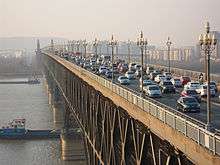Nanjing Yangtze River Bridge
| Nanjing Yangtze River Bridge 南京长江大桥 | |
|---|---|
 | |
| Coordinates | 32°06′55″N 118°44′20″E / 32.115278°N 118.738889°ECoordinates: 32°06′55″N 118°44′20″E / 32.115278°N 118.738889°E |
| Carries |
|
| Crosses | Yangtze River |
| Locale |
|
| Owner |
People's Government of Nanjing Shanghai Railway Bureau |
| Characteristics | |
| Design | Double-decked truss bridge |
| Material | Steel |
| Total length |
Main Bridge: 1,576 metres (5,171 ft) Highway: 4,588 metres (15,052 ft) Railway: 6,772 metres (22,218 ft) |
| Width |
Highway Bridge: 19.5 metres (64 ft) (with 4.5 metres (15 ft) pedestrian path) Railway: 14 metres (46 ft) |
| Height | 70 metres (230 ft) |
| Longest span | 160 metres (525 ft) |
| Number of spans | 10 |
| Clearance below | 24 metres (79 ft) |
| History | |
| Designer | Ministry of Railways |
| Construction begin | 18 January 1960 |
| Construction end |
Railway: 30 September 1968 Highway: 29 December 1968 |
| Replaces | Yangtze River Railway Ferry |
| Statistics | |
| Daily traffic |
80,000 vehicles 200 pairs of trains (2011) |
 Nanjing Yangtze River Bridge Location in Jiangsu | |
The Nanjing Yangtze River Bridge (Chinese: 南京长江大桥; pinyin: Nánjīng Chángjiāng Dàqiáo) is a double-decked road-rail truss bridge across the Yangtze River between Pukou and Xiaguan in Nanjing, China. Its upper deck is part of China National Highway 104, spanning 4,588 metres (15,052 ft). Its lower deck, with a double-track railway, is 6,772 metres (22,218 ft) long, and completes the Beijing-Shanghai Railway, which had been divided by the Yangtze for decades. Its right bridge consists of nine piers, with the maximum span of 160 metres (525 ft) and the total length of 1,576 metres (5,171 ft). The bridge carries approximately 80,000 vehicles and 200 trains per day.
The bridge was completed and open for traffic in 1968. It was the third bridge over the Yangtze after the Wuhan Yangtze River Bridge and the Chongqing Baishatuo Yangtze River Bridge. It was the first heavy bridge designed and built using Chinese expertise.
Suicide site
The Nanjing Yangtze River Bridge has surpassed the San Francisco Golden Gate Bridge as the most popular suicide site in the world, with more than 2,000 suicides estimated by 2006.[1] The majority of those who commit suicide at the bridge come from outside of Nanjing.[2] Precise statistics are unknown, as many bodies are never recovered and police do not include among the total deaths people who have jumped off the bridge, only to miss the water and hit the riverbanks below.[3] Police records from 2007 showed that 100 to 200 people are "rescued or restrained" each year on the bridge.[4]
A local man, Chen Si (Chinese: 陈思), has been hailed as a hero for saving the lives of more than 300 people planning to jump off the bridge.[5] Since 2004, Chen has devoted his free time to patrolling the bridge to help anyone in distress, including follow-up phone calls for support and offering them a place to stay in his extra bedroom.[3]
A feature documentary has been made about Chen Si and some of the people he has saved. It also goes into some of the reasons why so many people come here to try and end their lives. The film, titled Angel of Nanjing, has won several awards.[6]
Gallery
 Vehicles on the bridge
Vehicles on the bridge- Statue of first Yangtze river bridge at Nanjing
- Scenery on the river
 Nanjing Yangtze River Bridge seen from the upstream right bank
Nanjing Yangtze River Bridge seen from the upstream right bank- Perspective of the double-column frame piers of the railway bridge approach structure
See also
| Wikimedia Commons has media related to Nanjing Yangtze River Bridge. |
- Yangtze River bridges and tunnels
- Beijing–Shanghai Railway
- Rail transport in China
- Passenger rail transport in China
References
- Notes
- ↑ Sun Xiaoyu (September 28, 2006). :zh=2000自杀者为何选择南京长江大桥? [Why have 2,000 people killed themselves at the Nanjing Yangtze River Bridge?]. People's Daily (in Chinese). Retrieved January 12, 2015.
- ↑ Xu Dawei (15 October 2014). 邱志杰个展《南京长江大桥自杀干预计划(五)——齐物》在南京艺术学院美术馆开幕 [For jumpers, suicide at the Nanjing Yangtze River Bridge is like a 'pilgrimage']. Phoenix New Media (in Chinese). Retrieved 12 January 2015.
- 1 2 Michael Paterniti (May 2010). "The Suicide Catcher". GQ. Retrieved 12 January 2015.
- ↑ "Nanjing Yangtze Bridge Favorite Spot for Suicide". Xinhua News Agency. January 25, 2007. Retrieved 12 January 2015.
- ↑ Liang Chen (19 April 2013). "Man devotes life to thwarting suicide attempts, rehabilitating". Global Times. Retrieved 12 January 2015.
- ↑ http://www.AngelofNanjing.com
- Bibliography
- Gao Mobo (2008). The Battle for China's Past: Mao and the Cultural Revolution. Pluto Press: Verso. ISBN 978-0-7453-2780-8.
External links
- 纪录片《南京长江大桥》 Nanjing Yangtze River Bridge Documentary (Chinese language) (1969)
- How to get to the Yangtze River Bridge
- Yangtze River Bridge: The Historic Landmark of Modern Nanjing
